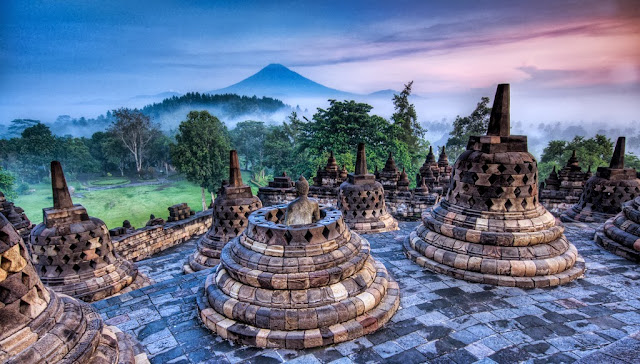 | |||
| A serene Buddha Image on the upper terrace of Borobudur. |
Borobudur was once described by French Scholar Albert Foucher as a "badly risen cake, of which the extent of its failure to rise is matched only by the over embellishment of its decoration." Today the world's largest Buddhist monument continues to rise out of the ashes that once buried it, attracting over a million visitors annually.
Story and pictures by Prisana Nuechterlein
When I was invited to join a tour heading to Borobudur, the world’s largest and most impressive Buddhist monument, I had imagined spending most of the day leisurely exploring the stunning architectural masterpiece. Instead, when our tour guide announced that we would only be viewing the monument for one hour, I honestly was in shock. We had been given hours to shop for batiks and handicraft items, and yet here we were on the threshold of one of the Seven Wonders of the Modern World and the time allotted to actually see it was incomprehensible.
Additionally, I was there to photograph and write about the famous Indonesian
site for the Bangkok Post and wondered how I could possibly take the images I
needed in only one hour? It was over a kilometer just to reach the top of the transcendental
sanctuary. I grabbed my camera equipment and literally started sprinting up the
ancient stone terraces, stopping every so often to take pictures of the
intricate relief panels.
 |
| Stone galleries depict the story of Buddha. |
Rising 15 meters above the fertile Kedu Plain, the monument’s site was
chosen where “the gods are seen at play” directly in the center of the Indonesian
island of Java. Bright green rice fields surround the monument, dominated by
Mount Merapi’s cone and the jagged Menoreh mountains. Of the two sets of neighboring
twin volcanoes, Mt Merapi alone remains active.
Built during the reign of the Sailendra dynasty, Borobudur predates
Angkor Wat by nearly three centuries. Archeologists are uncertain what inspired
Java’s most powerful family (whose name meant “Lord of the Mountains”) to build
the monument between AD 778-856. Nearly a century after its completion, “The Legendary
Temple of a Thousand Buddhas” was nearly buried under a shroud of volcanic ash
when Mt Merapi erupted violently.
The “re-discovery” of Borobudur to the Western world occurred in 1814,
when English Lieutenant-Governor Sir Thomas Stamford Raffles was informed of a
great ruined temple lying deep in Java’s interior. Raffles, a brilliant scholar
and historian, immediately dispatched H.C. Cornelius, his Dutch engineer to
investigate the site. Under his supervision 200 men worked steadily for nearly
a month and a half, removing the thick growth of vegetation and layer of earth
until a clear outline of the elaborate monument emerged.
In the following years, Borobudur suffered nearly a century of decay, plunder and abuse. Finally in 1900, the Dutch government established a committee for the preservation and restoration of the massive monument. The immense task of reconstruction was entrusted to Thadeus Van Erp, an ingenious 28 year old Dutch military engineer with an avid interest in Javanese antiquities.
Van Erp began his work by spending the first seven months excavating
the plateau around the monument’s foot. Buried beneath 1.3 meters of earth was
an impressive collection of Buddha heads, gargoyles, lions and decorative
items. Extensive restoration of all the balustrades, niches, lower stairs and
gates ensued. Collapsed walls were straightened and sunken stupas rebuilt. More
than half of the upper 72 stupas, (many of which had been destroyed by looters)
were remade out of new stone due to the scarcity of original material.
Although Van Erp accomplished the reconstruction in a relatively short
period of time, between 1907 and 1911, his ambitious plans for permanent
reconstruction were never realized due to the intervention of two world wars
and a depression. Indeed, Van Erp grew so attached to his “old grey pile of
rocks” that he was later buried close to the monument. His body, however, has
since been removed.
Some 60 years after Van Erp’s restoration efforts, Borobudur’s outer
walls began to bulge causing immense concern over its structural doom. Alarmed
by its inevitable destruction, a “Save Borobudur” campaign was launched in
1968, which was later supported by UNESCO. After a decade of arduous work and
over US$25 million was invested on the Borobudur Restoration Project, President
Suharto officially announced the completion in 1983, saying: “It is now to be
hoped that Borobudur will live a thousand years more.”
In total there are six square terraces leading to three circular platforms, forming what has been described as “a prayer in stone”.
 |
| Over 1,000 relief panels can be seen at Borobudur. |
The story of
Prince Siddhartha, from his glorious birth to his first sermon as Guatama
Buddha in Deer Park, is portrayed on thousands of bas relief panels on galleries
circumnavigating the terraces. Scenes depicting his previous incarnations and
the life of the Bodhisattva emerge in rich artistic style, showcasing a beautiful
mythical world unfolding with dancers, musicians, saints, ships and elephants.
Above the balustrades are 432 stone Buddhas placed in niches, conveying
the image of hermits meditating in caves upon a mountain top. The presence of
the Dhyani Buddhas gazing outwardly, each displaying one of six mudras or
symbolic hand positions, inspired an interpretation of Borobudur as a “cosmic
vihara, a monestary of perfected Buddhas meditating on the universe.”
The upper three circular terraces support 72 bell-shaped perforated
stupas, each of which encloses an “invisible” Buddha image that can only be seen
by peering into the diamond-shaped openings. Two tranquil Buddha images, with
their stupas dismantled attract the most attention from visitors. When visitors
finally reach the top of the monument they symbolically enter the formless world
of pure knowledge and perfection.
An aerial view of Borbudur clearly shows its spectacular mandalic design. In Sanskrit "mandala" means both circle and center. Seen as a mandala, the sacred monument's square terraces may symbolize the man-made world, while the upper round terraces; the infinite cosmos. Mandalic concepts were extremely important to ancient Javanese Buddhists as geometric tools for meditation, interpreted as universal symbols of integration, harmony and transformation. In this sense, Borobudur represents the world's most powerful and dramatic mandala.
 | |
| Picture by Trey Ratcliff |
An aerial view of Borbudur clearly shows its spectacular mandalic design. In Sanskrit "mandala" means both circle and center. Seen as a mandala, the sacred monument's square terraces may symbolize the man-made world, while the upper round terraces; the infinite cosmos. Mandalic concepts were extremely important to ancient Javanese Buddhists as geometric tools for meditation, interpreted as universal symbols of integration, harmony and transformation. In this sense, Borobudur represents the world's most powerful and dramatic mandala.
Unraveling the mysteries of Borobudur has mesmerized archeologists ever since its discovery. Although many questions may never be resolved, what remains clear is that Borobudur was created as a magnificent visual representation of man's spiritual journey toward enlightenment; a journey that takes time and would be best embarked upon without sprinting.
























